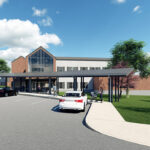From heat wave to drenching downpours—welcome to summer in central Pennsylvania. But these recent weather events are more than just standard issue for our region; they also remind us that our infrastructure needs to be built to withstand extreme conditions.
Managing stormwater remains our biggest challenge—and we are not alone. Harrisburg is one of 800 cities nationwide with a combined sewer system. The same pipes that carry away household sewage and wastewater also carry stormwater from rooftops and pavement.
Capital Region Water captured and treated 92% of all combined sewage and stormwater in 2020, and on average treats 90% annually. The 8% that went untreated was primarily the result of heavy rains overwhelming Harrisburg’s aging and undersized infrastructure.
The summer months are when we typically see these cloud bursts, heavy runoff and localized flooding, drawing attention to the work we do year-round to protect our local waterways.
During dry weather or light rainfall events, both stormwater and wastewater go to the authority’s Advanced Wastewater Treatment Facility for treatment before clean water is released into the Susquehanna River. During moderate to heavy rainfall events, as we just witnessed, or due to pipe obstruction caused by debris or commercial fats, the combined system reaches capacity and a mixture of sewage and stormwater overflows into the Susquehanna River and/or Paxton Creek.
These combined sewer overflow (CSO) events are a symptom of our aged infrastructure, not an operational choice, and there is no easy solution or cheap fix to the problem. While more certainly needs to be done, much has been accomplished.
Since its inception in 2013, Capital Region Water has invested more than $130 million to improve our water and wastewater infrastructure, address a backlog of deferred maintenance projects that stretches back decades, and collaborate with ratepayers and stakeholders to meet our most pressing local needs while fulfilling state and federal clean water requirements.
But wet weather events remain a unique challenge. To address the issue, Capital Region Water is rehabilitating existing infrastructure and installing new systems that collect and convey stormwater and wastewater, increasingly limiting overflows into the Susquehanna River and Paxton Creek.
Some of that work is already under way, and you can see progress in every city neighborhood.
System rehabilitation by way of cleaning, flushing and rebuilding pipes, inlets and manholes is occurring throughout our service territory. Capital projects at our primary pumping station on Front Street are increasing by 50% the volume of flow that reaches our treatment facility; improvements at the treatment facility optimize the process.
Perhaps most visible are the decentralized projects occurring on our streets and at our playgrounds. These green and gray infrastructure projects capture stormwater where it originates. Not only are some of these smaller but highly effective projects more affordable for a financially challenged city like ours, but they also provide local benefits by reducing street flooding and greening communities.
In Summit Terrace, for example, Capital Region Water along with neighborhood partners transformed 12 vacant lots into a community amenity. The associated rain garden and infiltration system captures and manages 1 million gallons of stormwater each year from the area but also features remediated soils, a pollinator habitat, and green space for the community.
Finding equitable, affordable ways to manage stormwater and polluted runoff is a priority. Every property owner must pay their fair share and every dollar must be invested in solutions.
Capital Region Water has developed a long-term financing plan that utilizes state revolving loan funds at sub-market rates, relies on strong local banking relationships to establish lines of credit for interim borrowing, examines other state and federal funding opportunities, and offers a robust customer assistance program that aids residents who are already in the high-burden rate category based on federal financial capability guidance.
As one of Harrisburg’s anchor institutions, we are ensuring minority, women and disadvantaged business enterprises (MWDBE) have equal opportunity to participate in all related construction contracts while balancing the long-term capital and operational needs of the utility with the ability of our customers to pay. Residents will have a say in any plan to meet CSO regulatory requirements.
Just as we have done over the last seven years, Capital Region Water will continue to complete projects that ensure system resiliency and efficiency while reducing combined sewer overflows. In understanding the problem and challenges, together we can implement solutions that repair aging infrastructure, rebuild our communities, and improve the health of local waterways.
Charlotte Katzenmoyer is chief executive officer of Capital Region Water.
If you like what we do, please support our work. Become a Friend of TheBurg!






